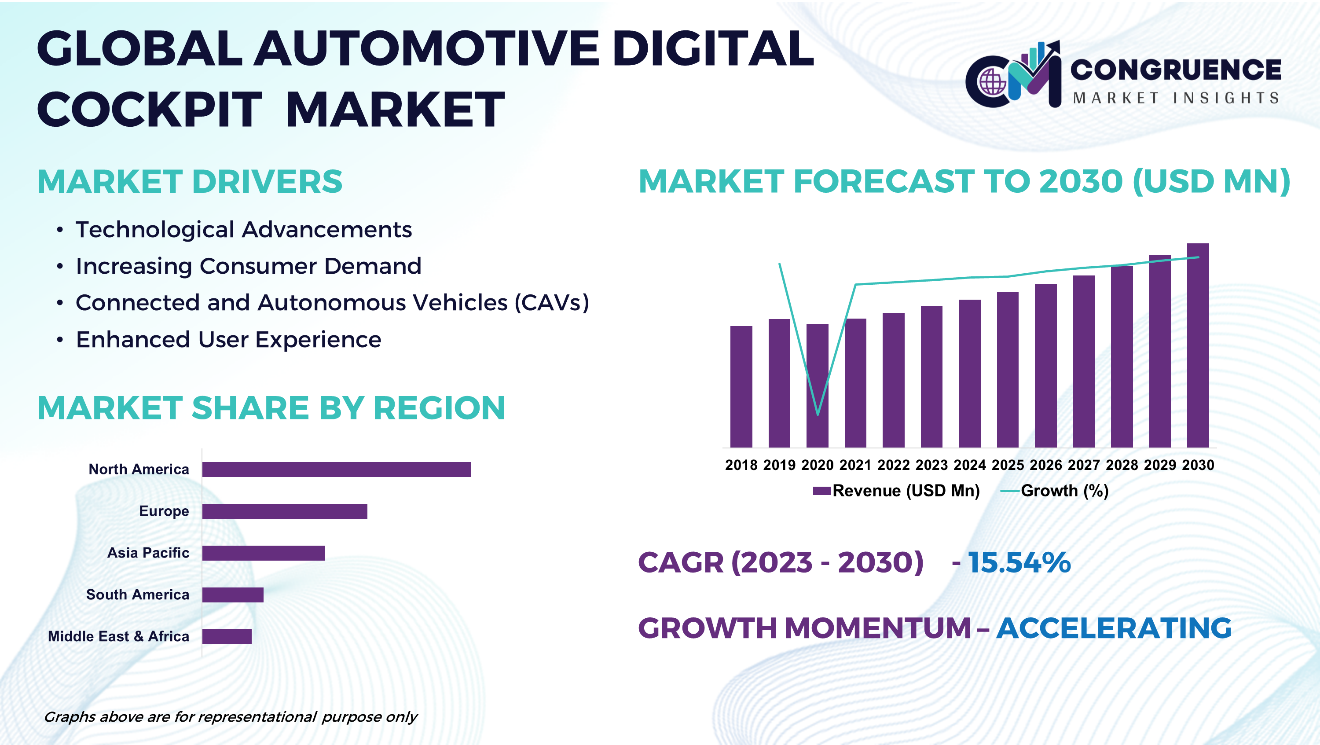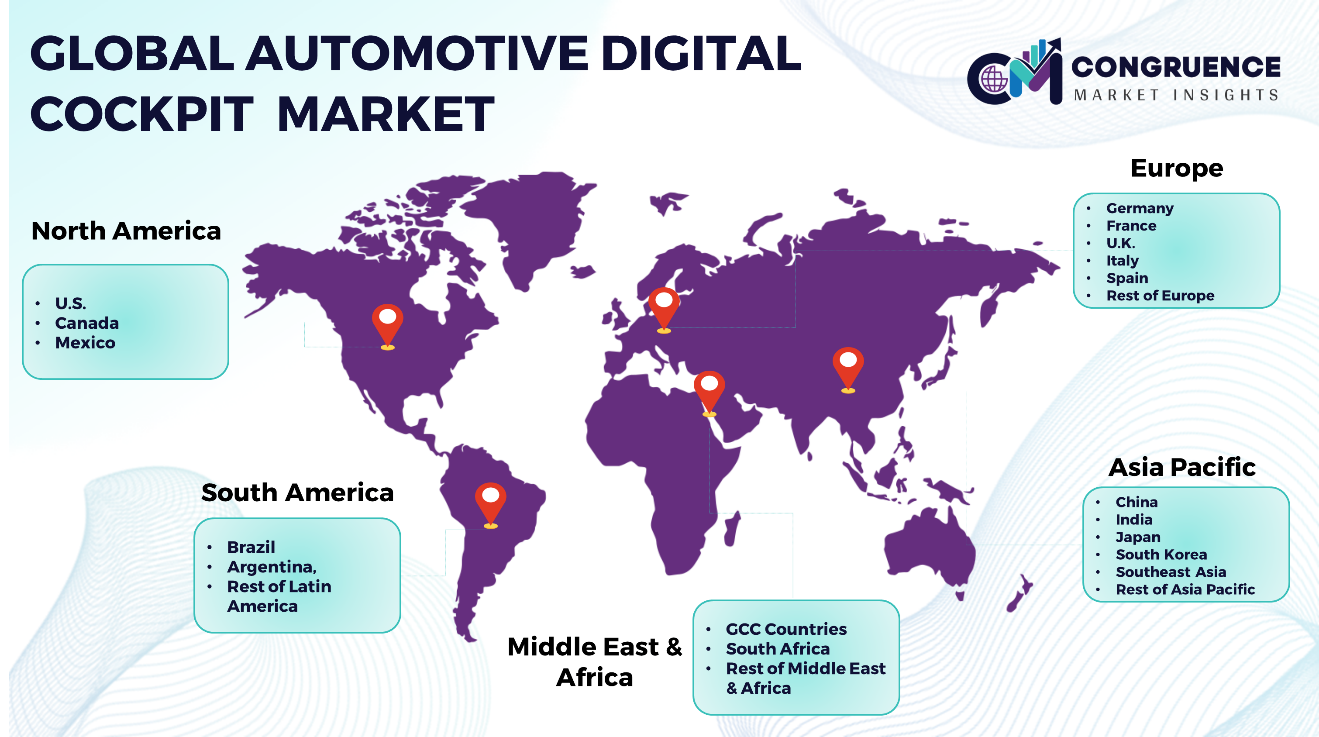Reports
The Global Automotive Digital Cockpit Market is expected to expand at a CAGR of 15.54% between 2023 and 2030. The Automotive Digital Cockpit Market undergoes rapid evolution spurred by technological advancements and innovations. These digital cockpits, which amalgamate various vehicle functions and information displays, are fundamentally reshaping the driving experience. Progressions such as augmented reality (AR) HUDs, voice recognition systems, gesture control interfaces, and the integration of artificial intelligence (AI) contribute to enhanced safety, connectivity, and user interaction. The market landscape mirrors intense competition among key players such as Visteon Corporation, Continental AG, and Harman International Industries, who engage in collaborations with tech firms to incorporate cutting-edge features. With the growing demand for connected and autonomous vehicles, significant market growth is anticipated, particularly in regions like Asia Pacific and North America. This surge is propelled by the escalating consumer preference for advanced infotainment and safety features.

Automotive Digital Cockpit Market Major Driving Forces
Technological Advancements: Swift progress in digital technology, encompassing augmented reality (AR), artificial intelligence (AI), gesture control interfaces, and voice recognition systems, is fundamentally reshaping automotive cockpit design and functionality.
Increasing Consumer Demand: The rising consumer desire for advanced infotainment, connectivity, and safety features in vehicles is spurring the adoption of digital cockpits. Consumers are seeking seamless integration of entertainment, communication, and navigation systems within their vehicles.
Connected and Autonomous Vehicles (CAVs): The emergence of connected and autonomous vehicles is driving demand for digital cockpits capable of seamless integration with vehicle-to-vehicle (V2V) and vehicle-to-infrastructure (V2I) communication systems, as well as support for autonomous driving functionalities.
Enhanced User Experience: Digital cockpits are offering improved user experiences through intuitive interfaces, customizable displays, and personalized features, catering to the preferences of modern consumers who expect seamless digital experiences in their vehicles.
Automotive Digital Cockpit Market Key Opportunities
Integration of Advanced Technologies: There's potential to integrate state-of-the-art technologies like augmented reality (AR), artificial intelligence (AI), and biometric sensors into digital cockpits, elevating user experience and vehicle functionality.
Enhanced Connectivity: With the rise of connected vehicles and the Internet of Things (IoT), there's a significant opportunity to boost connectivity within digital cockpits. This involves seamless integration with smartphones, wearable devices, and smart home systems for advanced features such as remote vehicle monitoring and control.
Data Monetization: Digital cockpits generate vast data related to vehicle performance, user behavior, and environmental conditions. There are opportunities to leverage this data for predictive maintenance, targeted advertising, and personalized services.
Integration with Autonomous Driving Systems: With the emergence of autonomous vehicles, integrating digital cockpits with advanced driver assistance systems (ADAS) and autonomous driving technologies presents opportunities. This includes features like augmented reality head-up displays (HUDs) and user interfaces designed for autonomous driving scenarios.
Automotive Digital Cockpit Market Key Trends
· Growing adoption of voice control interfaces and natural language processing systems within digital cockpits, allowing drivers to interact with infotainment systems, navigation, and other vehicle functions hands-free.
· Integration of ADAS features like lane departure warning, adaptive cruise control, and collision avoidance systems directly into digital cockpits, enhancing safety and convenience for drivers.
· Incorporation of biometric sensors for driver identification, health monitoring, and personalized settings within digital cockpits, enabling customized driving experiences and enhanced security.
· Continued focus on connectivity features such as smartphone integration, wireless charging, and seamless connectivity with IoT devices, enabling passengers to stay connected while on the move.
· Increasing integration of AR technology into digital cockpits for enhanced visualization of navigation, vehicle information, and safety alerts, providing a more immersive driving experience.
· Adoption of high-resolution displays and curved screens within digital cockpits, providing crisp visuals and allowing for more flexible and dynamic information presentation.
· Utilization of AI and machine learning algorithms for predictive analytics, personalized recommendations, and proactive maintenance alerts within digital cockpits, improving overall vehicle performance and user experience.

Market Competition Landscape
The market competition landscape of the Automotive Digital Cockpit sector is marked by vigorous competition among industry leaders. Players vie for market share through continuous product innovation, technological advancements, and strategic partnerships. Moreover, the entrance of new contenders further heightens competition, fostering a climate of ongoing innovation and development within digital cockpit solutions.
Key players in the global Automotive Digital Cockpit market implement various organic and inorganic strategies to strengthen and improve their market positioning. Prominent players in the market include:
· Robert Bosch GmbH
· Visteon Corporation
· Denso Corporation
· Continental AG
· HARMAN International
· Marelli Holdings Co., Ltd.
· Panasonic Automotive Systems Co., Ltd.
· DESAY Industry
· Arm Limited
· Qualcomm Technologies, Inc.
· Luxoft (DXC Technology Company)
· Aptiv
· Magna International Inc.
· Infineon Technologies AG
· Pioneer Corporation
|
Report Attribute/Metric |
Details |
|
Base Year |
2022 |
|
Forecast Period |
2023 – 2030 |
|
Historical Data |
2018 to 2022 |
|
Forecast Unit |
Value (US$ Mn) |
|
Key Report Deliverable |
Revenue Forecast, Growth Trends, Market Dynamics, Segmental Overview, Regional and Country-wise Analysis, Competition Landscape |
|
Segments Covered |
· By Product Type (Instrument Cluster, Infotainment System, Head-Up Display (HUD), Advanced Driver Assistance System (ADAS), and Others) · By Display Technology (LCD (Liquid Crystal Display), OLED (Organic Light-Emitting Diode), TFT (Thin-Film Transistor), and Others) · By Cockpit Type (Conventional Cockpit, Semi-Autonomous Cockpit, and Autonomous Cockpit) · By End Use Application (Passenger Cars, and Commercial Vehicles) · By Sales Channel (OEMs (Original Equipment Manufacturers), and Aftermarket) |
|
Geographies Covered |
North America: U.S., Canada and Mexico Europe: Germany, France, U.K., Italy, Spain, and Rest of Europe Asia Pacific: China, India, Japan, South Korea, Southeast Asia, and Rest of Asia Pacific South America: Brazil, Argentina, and Rest of Latin America Middle East & Africa: GCC Countries, South Africa, and Rest of Middle East & Africa |
|
Key Players Analyzed |
Robert Bosch GmbH, Visteon Corporation, Denso Corporation, Continental AG, HARMAN International, Marelli Holdings Co., Ltd., Panasonic Automotive Systems Co., Ltd., DESAY Industry, Arm Limited, Qualcomm Technologies, Inc., Luxoft (DXC Technology Company), Aptiv, Magna International Inc., Infineon Technologies AG, Pioneer Corporation |
|
Customization & Pricing |
Available on Request (10% Customization is Free) |
